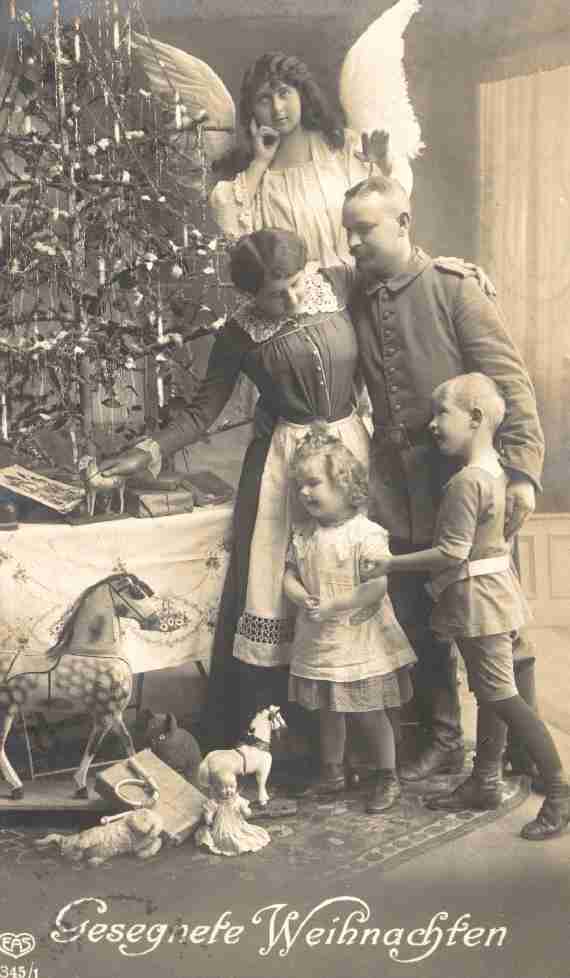
World War I Trench Warfare: German Cards and Letters Home

Figure 1.--This card was sent by a German soldier in the trenches of the Western Front in 1915. It shows a German soldier at home with his family. The caption reads, "Gesegnefe Weihnachfen". That means, "Blessed Christmas". Click on the image to see the message on the back of the card. Image courtesy of the MD collection.
|
HBC has a number of cards mailed by World War I German soldiers from the trenches to their loved ones at home.
Specific Cards
HBC has begun to acquire individual cards written by German soldiers.
1915 card
This card was sent by a German soldier in the trenches of the Western Front during December 1915 at the height of the War (figure 1). It shows a German soldier at home with his family. The caption reads, "Gesegnefe Weihnachfen". That means, "Blessed Christmas".
The address on this card is: An Fraeulein Luise Schlueter, Kottebrink b. Bruchmuehlen,
Kreis Melle, Bezirk Osnabrueck. In English thiswould read: To Miss Luise Schlueter,
Kottebrink near Bruchmuehlen, District Melle, County Osnabrueck. The German text is: "Liebe Luise, Ich wollte Dir einen schoenen Weihnachtsgruss schicken aus dem Feld.
Den besten Gruss aus dem Feld sendet Dir Dein lieber. Karl" English translation:
"Dear Luise, I wanted to send you nice Christmas greetings from the field (front).
The best greeting from the field is sending you, your dear Karl." Aand then somewhere: geschrieben am 5.12.15 = written on December 5 1915. The postmark is Secember 6. The day in Germany is celebrated "Nikolaus". In fact, in Germany we write first day, than month and than year. Karl may have been dutiful in writing his intendd, but he certainly wasn't the most romantic person inthe world. The little girl on the card. wears a dress and pinafore. The boy wears a short pannts tunic suit with a square sailor collar and long stockings. Notice the boy's short hair cut. The choice is telling. Of all the holidays, Christmas is dearest to the German people. Tragcally few of the soldiers on the Western front could be home for Christmas.
This card was sent by a German soldier in the trenches of the western Front in March 1918. The card is a portrait of a German boy in a sailor suit and cap. The boy wears a sailor cap with "?S Brest" on the tally (cap band). On British caps the names of ships were displayed. This may represent the city of Brest. The treaty between the Bolshevicks and the Germans ending the War in the east was known as the Traety of Brest-Litosk which was signed in 1918. The caption reads, "Ein blauer Junge!" (This translated as "A blue boy", meaning a sailor boy. The message written on the back of the card can be viewed by clicking on the image. The card has also been signed by an officer (I presume) named Wiegand just above 'Feldpost - so perhaps the German censor system was very similar to that of the British one.
German Censors
Postcards today or a rather minor matter, primarily relegated to tourist spot. In the early 20th century, post cards were big business nd much more commonly used for family communication. Remember in 1914-18 that there were no cell phones and a telephone call from France back to England would have been a major undertaking. Only the families of some wealthy officers would have had telephones in their homes. A call home from France would have been mmajor event. HBC readers may want to visit the HBC German post card page for back ground on these cards.
Christopher Wagner

Navigate the Boys' Historical Clothing Web Site:
[Return to Main World War I country card page]
[Return to Main military style page]
[Introduction]
[Activities]
[Biographies]
[Chronology]
[Clothing styles]
[Countries]
[Bibliographies]
[Contributions]
[Essays]
[FAQs]
[Glossaries]
[Satellites]
[Tools]
[Boys' Clothing Home]
Created: January 19, 2003
Last updated: January 19, 2003



